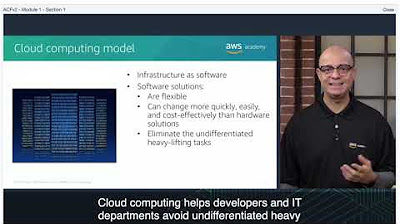Cloud Engineer: Apache CloudStack - Install, Build and Run IaaS Cloud
Summary
TLDRThis module introduces Apache CloudStack, an open-source IaaS platform from the Apache Software Foundation, which manages pools of computing resources to build public or private clouds. It covers CloudStack's history, core components, and key concepts, setting the stage for implementing cloud environments. The script discusses cloud computing basics, benefits, service models (IaaS, PaaS, SaaS), and deployment configurations (public, private, hybrid). It also highlights CloudStack's features, user interface, API, hypervisor support, and its role in job opportunities and professional growth in the cloud industry.
Takeaways
- 🌟 Apache CloudStack is an open-source IaaS platform that manages and orchestrates pools of storage, network, and computing resources to build a public or private cloud.
- 📚 The course introduces CloudStack's history, core components, key concepts, and terminology, serving as a foundation for implementing a cloud environment.
- 💻 Traditional IT infrastructure deployment was time-consuming and costly, often leading to energy waste and low hardware utilization.
- 🌐 Cloud computing offers on-demand access to a shared pool of computing resources, with benefits like reduced upfront costs, rapid scalability, and environmental advantages.
- 🚀 CloudStack supports various hypervisors, including KVM, VMware vSphere, XenServer, Hyper-V, and more, making it versatile for different virtualization needs.
- 🏢 The platform is written in Java and includes an API and web GUI for managing virtual machines and creating VM templates.
- 🌱 CloudStack originated as 'vm ops' in 2008, evolved through acquisitions, and became a top-level project of the Apache Software Foundation.
- 🏭 Notable users of CloudStack include Apple, Zynga, Nokia, and various major service providers, indicating its adoption in the industry.
- 📈 Knowledge of CloudStack is in high demand, offering job opportunities and professional growth within startups and large enterprises.
- 🛠️ CloudStack provides an out-of-the-box user interface and a powerful, well-documented API for easy integration and management of cloud resources.
- 🌍 The platform's infrastructure is organized hierarchically, including regions, zones, pods, clusters, primary storage, and secondary storage for efficient resource management.
Q & A
What is the basic concept of cloud computing?
-Cloud computing is a platform that provides hosted services over a network, utilizing hardware virtualization to offer access to a shared pool of computing resources on a rental or lease basis.
What are some of the main benefits of cloud computing?
-The main benefits of cloud computing include avoiding upfront infrastructure costs, rapid application deployment, scalability to meet fluctuating demands, and environmental advantages due to efficient data center management.
What are the three main service models of cloud computing?
-The three main service models are Infrastructure-as-a-Service (IaaS), Platform-as-a-Service (PaaS), and Software-as-a-Service (SaaS).
What is Apache CloudStack and what does it enable?
-Apache CloudStack is an open-source IaaS platform that manages and orchestrates pools of storage, network, and computing resources to build a public or private IaaS compute cloud. It supports various hypervisors and can be used to deploy and manage cloud environments.
How did Apache CloudStack come into existence?
-Apache CloudStack began as a startup project in 2008 known as VMOps, later renamed to Cloud.com, and was submitted to the Apache Incubator in 2012. It graduated from the incubator in 2013 and released its first major version 4 in the same year.
What are the key features of Apache CloudStack?
-Key features of Apache CloudStack include a rich user interface, a powerful and easy-to-build-upon API, support for multiple hypervisors, automation of resource distribution, and security built upon open architecture.
What is the role of a management server in Apache CloudStack?
-The management server in Apache CloudStack controls the allocation of virtual machines to hosts and assigns storage, IP addresses, and other resources to the virtual machines launched within the cloud.
What is the significance of regions, zones, and pods in Apache CloudStack's infrastructure?
-Regions, zones, and pods in Apache CloudStack's infrastructure represent different organizational units for managing resources. Regions provide fault tolerance and disaster recovery, zones offer physical isolation and redundancy, and pods are collections of hardware resources configured in clusters.
How does the concept of a 'cluster' function within Apache CloudStack?
-A cluster in Apache CloudStack is a group of identical hosts running a common hypervisor. It is contained within a pod and is limited by the underlying hypervisor's capacity, with each cluster having a dedicated primary storage device for hosting VM instances.
What is the purpose of primary and secondary storage in Apache CloudStack?
-Primary storage in Apache CloudStack is where virtual machine instances are hosted, and it is dedicated to each cluster. Secondary storage is shared by all pods in a zone and is used for storing templates, ISOs, and snapshots.
Why are professionals with knowledge of CloudStack in high demand?
-Professionals with knowledge of CloudStack are in high demand due to its popularity and the wide range of job opportunities it offers in both service provider companies running public cloud services and corporations building private cloud instances.
Outlines

Этот раздел доступен только подписчикам платных тарифов. Пожалуйста, перейдите на платный тариф для доступа.
Перейти на платный тарифMindmap

Этот раздел доступен только подписчикам платных тарифов. Пожалуйста, перейдите на платный тариф для доступа.
Перейти на платный тарифKeywords

Этот раздел доступен только подписчикам платных тарифов. Пожалуйста, перейдите на платный тариф для доступа.
Перейти на платный тарифHighlights

Этот раздел доступен только подписчикам платных тарифов. Пожалуйста, перейдите на платный тариф для доступа.
Перейти на платный тарифTranscripts

Этот раздел доступен только подписчикам платных тарифов. Пожалуйста, перейдите на платный тариф для доступа.
Перейти на платный тарифПосмотреть больше похожих видео

Cloud Models - CompTIA A+ 220-1101 - 4.1

Cloud Models - CompTIA A+ 220-1001 - 4.1

Module 1 - Section 1 : Introduction to Cloud Computing

Nginx vs Apache Webservers: Main Differences

Cloud Computing In 6 Minutes | What Is Cloud Computing? | Cloud Computing Explained | Simplilearn

Open-Source Technology for Big Data Analytics
5.0 / 5 (0 votes)
